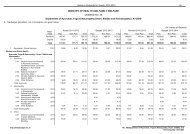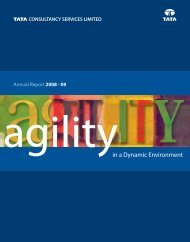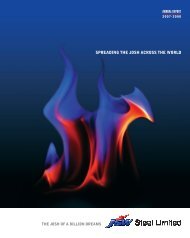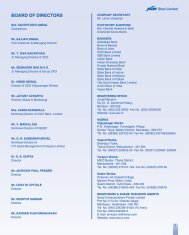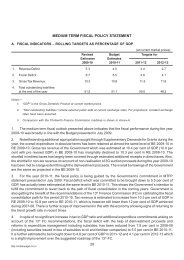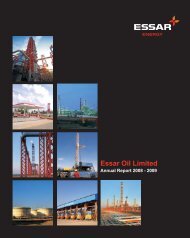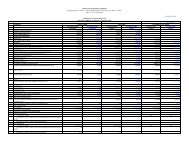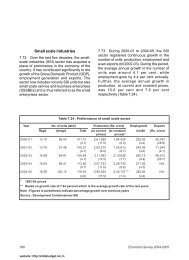videocon industries limited - Domain-b
videocon industries limited - Domain-b
videocon industries limited - Domain-b
You also want an ePaper? Increase the reach of your titles
YUMPU automatically turns print PDFs into web optimized ePapers that Google loves.
Year ended on<br />
30th Sept., 2008<br />
(Rupees in Million)<br />
Year ended on<br />
30th Sept., 2007<br />
(Rupees in Million)<br />
SCHEDULE 13 : MANUFACTURING AND<br />
OTHER EXPENSES<br />
Power, Fuel & Water 867.73 731.61<br />
Freight & Forwarding 1,075.18 958.76<br />
Rent 158.72 135.23<br />
Rates & Taxes 69.66 129.74<br />
Repairs to Building 31.71 31.74<br />
Repairs to Plant & Machinery 85.13 95.24<br />
Repairs & Maintenance-others 62.55 54.37<br />
Insurance Expenses 68.13 85.85<br />
Advertisement & Publicity 1,045.77 965.46<br />
Sales Promotion Expenses 215.49 190.11<br />
Discount & Incentive Schemes 2,107.60 1,990.38<br />
Bank Charges 307.58 265.21<br />
Auditiors’ Remuneration 10.80 8.33<br />
Donation 91.70 71.58<br />
(Includes Amount Paid to Rashtriya Janata<br />
Dal Rs.5.00 million, Nationalist Congress<br />
Party Rs.10.00 million, All India Congress<br />
Committee Rs.20.00 million, Swatantra Bharat<br />
Paksha Rs.2.5 million, Bharitya Janta Party<br />
Rs.25.00 million (Previous year Rs.5.00 million<br />
Rashtriya Janata Dal)<br />
Directors’ Sitting Fees 1.32 1.18<br />
Legal & Professional Charges 230.22 128.09<br />
Royalty 69.60 72.14<br />
Printing & Stationery 24.18 21.96<br />
Warranty and Maintenance Expenses 606.66 581.48<br />
Loss on Sale of Fixed Assets - 1.45<br />
Provision for doubtful debts 38.99 27.73<br />
Exchange Rate Fluctuation 342.29 -<br />
Miscellaneous Expenses 304.62 244.19<br />
TOTAL 7,815.63 6,791.83<br />
SCHEDULE 14 : INTEREST AND FINANCE<br />
CHARGES<br />
On Fixed Period Borrowings 3,629.35 2,709.99<br />
On Others 381.68 396.52<br />
TOTAL 4,011.03 3,106.51<br />
SCHEDULE - 15 : SIGNIFICANT ACCOUNTING POLICIES AND NOTES TO ACCOUNTS<br />
A] SIGNIFICANT ACCOUNTING POLICIES :-<br />
1. Basis of Accounting:<br />
a) The financial statements are prepared under historical cost convention, except for<br />
certain Fixed Assets which are revalued, using the accrual system of accounting<br />
in accordance with the accounting principles generally accepted in India (Indian<br />
GAAP) and the requirements of the Companies Act, 1956, including the mandatory<br />
Accounting Standards issued by the Institute of Chartered Accountants of India, as<br />
referred to in Section 211 (3C) of the Companies Act, 1956.<br />
b) Use of Estimates<br />
The preparation of financial statements requires the management of the Company<br />
to make estimates and assumptions that affect the reported balances of assets and<br />
liabilities and disclosures relating to the contingent liabilities as at the date of the<br />
financial statements and reported amounts of income and expenses during the year.<br />
Example of such estimates include provisions for doubtful debts, employee retirement<br />
benefits plans, provision for income tax, accounting for contract costs expected to be<br />
incurred to complete software development and the useful lives of fixed assets.<br />
2. Fixed Assets:<br />
a) Fixed Assets are stated at actual cost, except for certain fixed assets which have<br />
been stated at revalued amounts, less accumulated depreciation / amortisation and<br />
impairment loss, if any. The actual cost is inclusive of freight, installation cost, duties,<br />
taxes, financing cost and other incidental expenses but net of Cenvat/Value added<br />
tax.<br />
b) Capital Work in Progress is carried at cost, comprising of direct cost, attributable<br />
interest and related incidental expenditure. The advances given for acquiring fixed<br />
assets are shown under Capital Work in Progress.<br />
3. Joint Ventures for Oil and Gas Fields:<br />
a) In respect of joint ventures in the nature of Production Sharing Contracts (PSC)<br />
entered into by the Company for oil and gas exploration and production activities, the<br />
Company’s share in the assets and liabilities as well as income and expenditure of<br />
Joint Venture Operations are accounted for according to the Participating Interest of<br />
the Company as per the PSC and the Joint Operating Agreements on a line-by-line<br />
basis in the Company’s Financial Statements.<br />
b) In respect of joint ventures in the form of jointly controlled entities, the income on<br />
investments in incorporated jointly controlled entities is recognised when the right to<br />
receive the same is established and investment in such joint venture is carried at cost<br />
after providing for any permanant diminution in value.<br />
31<br />
4. Exploration, Development Costs and Producing Properties:<br />
The Company follows the “Successful Efforts Method” of accounting for oil and gas<br />
exploration, development and production activities as explained below:<br />
a) Exploration costs involved in drilling and equipping exploratory and appraisal wells,<br />
test wells are initially capitalised as Exploratory Wells in Progress till the time these<br />
are either transferred to Producing Properties on completion as per Policy No. (c)<br />
below or expensed in the year when determined to be dry or of no further use.<br />
b) All costs relating to Development Wells are initially capitalised as Development Wells<br />
in Progress and transferred to Producing Properties on completion as per Policy No.<br />
(c) below. Costs includes recharge to the Joint Venture by the operator / Affiliate.<br />
c) Producing Properties are created in respect of an area / field having proved developed<br />
oil and gas reserves, when the area/field is ready to commence commercial production.<br />
Cost of successful exploratory wells, all development wells, depreciation on related<br />
equipment, facilities and estimated future abondonment costs are capitalised and<br />
reflected as Producing Properties.<br />
5. Abandonment Costs:<br />
The full eventual estimated liability towards costs relating to dismantling, abandoning and<br />
restoring well sites and allied facilities is recognised as cost of producing property and as<br />
liability for abandonment cost based on evaluation by experts at current costs. The same is<br />
reviewed periodically.<br />
6. Depreciation and Amortisation:<br />
The Company provides depreciation on fixed assets held in India on written down value<br />
method in the manner and at the rates specified in the Schedule XIV to the Companies Act,<br />
1956 except (a) on Fixed Assets of Consumer Electronics Divisions other than Glass Shell<br />
Division and; (b) on office buildings acquired after 01.04.2000, on which depreciation is<br />
provided on straight line method at the rates specified in the said Schedule. Depreciation on<br />
fixed assets held outside India is calculated on straight line method at the rates prescribed<br />
in the aforesaid Schedule or based on useful life of assets whichever is higher. Producing<br />
Properties are depleted using the “Unit of Production Method”. The rate of depletion is<br />
computed in proportion of oil and gas production achieved vis-a-vis proved reserves.<br />
Leasehold Land is amortised over the period of lease.<br />
Intangibles: Intangible assets are amortised over a period of five years.<br />
7. Impairment of Assets :<br />
The Fixed Assets or a group of assets (Cash generating unit) and Producing Properties<br />
are reviewed for impairment at each Balance Sheet date. In case of any such indication,<br />
the recoverable amount of these assets or group of assets is determined, and if such<br />
recoverable amount of the asset or cash generating unit to which the asset belongs is less<br />
than it’s carrying amount, the impairment loss is fixed by writing down such assets and<br />
Producing Properties to their recoverable amount. An impairment loss is reversed if there is<br />
change in the recoverable amount and such loss either no longer exists or has decreased.<br />
8. Investments:<br />
a) Current Investments : Current Investments are carried at lower of cost or quoted/fair<br />
value.<br />
b) Long Term Investments : Quoted Investment are valued at cost or market value<br />
whichever is lower. Unquoted Investments are stated at cost. The decline in the value<br />
of the unquoted investment, other than temporary, is provided for.<br />
Cost is inclusive of brokerage, fees and duties but excludes Securities Transaction<br />
Tax.<br />
9. Inventories:<br />
Inventories including crude oil stocks are valued at cost or net realisable value whichever<br />
is lower. Cost of inventories comprises all costs of purchase, conversion and other<br />
costs incurred in bringing the inventories to their present location and condition. Cost is<br />
determined on Weighted Average basis.<br />
10. Borrowing Costs:<br />
Borrowing costs that are directly attributable to the acquisition, construction or production of<br />
an qualifying asset are capitalised as part of the cost of that asset. Other borrowing costs<br />
are recognised as an expense in the period in which they are incurred.<br />
11. Excise and Customs Duty:<br />
Excise Duty in respect of finished goods lying in factory premises and Customs Duty on<br />
goods lying in customs bonded warehouse are provided for and included in the valuation of<br />
inventory.<br />
12. CENVAT/Value Added Tax:<br />
Cenvat/Value Added Tax Benefit is accounted for by reducing the purchase cost of the<br />
materials/fixed assets.<br />
13. Revenue Recognition:<br />
a) Revenue is recognised on transfer of significant risk and reward in respect of<br />
ownership.<br />
b) Sale of Crude Oil and Natural Gas are exclusive of Sales Tax. Other Sales/turnover<br />
includes sales value of goods, services, excise duty, duty drawback and other<br />
recoveries such as insurance, transportation and packing charges but excludes sale<br />
tax and recovery of financial and discounting charges.<br />
c) Insurance, Duty Drawback and other claims are accounted for as and when admitted<br />
by the appropriate authorities.<br />
14. Foreign Currency Transactions:<br />
a) Transactions in foreign currencies are recorded at the exchange rate prevailing on the<br />
date of transactions. Current Assets and Current Liabilities are translated at the year<br />
end rate. The difference between the rate prevailing on the date of transaction and on<br />
the date of settlement as also on translation of Current Assets and Current Liabilities<br />
at the end of the year is recognised, as the case may be, as income or expense for<br />
the year.<br />
b) Foreign Currency liabilities in respect of loans availed for fixed assets and outstanding<br />
on the last day of the financial year are translated at the exchange rate prevailing on<br />
that day and any loss or gain arising out of such translation is recognised, as the case<br />
may be, as income or expense for the year.




